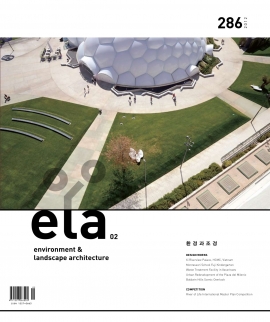Montessori School Fuji Kindergarten
TAKAHARU +YUI TEZUKA ARCHITECTS | www.tezuka-arch.com
우리가 이곳에 만든 유일한 놀이시설은 미끄럼틀 하나밖에 없다. 지붕 위에는 놀이시설이 하나도 없다. 사실 예산이 없어 포기한 것이지만, 놀이시설이 없는 것에 대한 결과는 매우 훌륭했다. 옥상 자체가 놀이시설이 되었기 때문이다. 여기에서 필요한 것은 지붕이었다. 시공하는 동안 우리는 가우디의 ‘카사 밀라’를 보러 갔다. 기이하고도 불규칙한 굴뚝과 창문이 가득한 지붕을 보는 것이 우리의 목적이었다. 사실 우리는 17년 전에 그곳을 방문했었다. ‘카사 밀라’에는 놀이시설이 없다. 유치원이 아니니까 당연한 일이지만, 우리의 네 살과 한 살 먹은 아이들은 주위를 뛰어다니며 소리 지르는 것을 멈추지 않았다. 몇 번이나 넘어져 찰과상을 입고 울음을 터뜨렸지만, 이들은 곧 다시 주위를 뛰어다녔다. 아이들만 여기에서 재미있게 놀았던 것은 아니다. 어른들도 즐거워했다. 그런데 아이들이 너무나 좋아하는 미야자키 하야오의 ‘이웃집 토토로’에 등장하는 ‘사츠키와 메이의 집’은 디자이너가 일본식 가옥과 서양식 주택으로 증축된 부분을 뒤죽박죽 섞어 놓은 것이다. 한 장면에서 이들은 2층으로 올라가는 비밀 계단을 찾는다. 이들은 둥근 장지문에서 불쑥 튀어나와 있는 머리에 깜짝 놀란다. 하지만 우리가 좋아했던 것은 그것이 아주 평범한 건축 요소였다는 점이다. 그것은 고안된 장치가 아니었다. 그것이 “주어진 것”이 아니라 “발견된 것”이라는 점이 중요하다. 아이에게 맞도록 만들어졌다면, 어른은 이를 즐기지 못한다. 즉, 어른과 아이의 시선은 다르다. 동시에, 한 아이의 시선이 다른 아이의 시선과 같지 않은 등의 물리적 강도도 다르다. 좋아하는 것도 다르다. 즉, 우리는 시선을 결정할 수 없다. 놀이시설은 아이들이 놀도록 어른들이 고안한 도구들로 이루어진다. 놀이터가 주어지고, 노는 방법은 제한된다. 아이들은 스스로 장소를 찾아내는 데 명수이다. 아이들은 채광창을 보고 후지 유치원의 옥상에서 장소를 찾아낼 수 있다. 지붕이 루프에 연결된 첫날, 선생님들이 각 반을 옥상으로 데리고 갔지만 아이들은 결코 선생님과 함께 있지 않았다. 이들은 채광창 주변에 모여 움직이지 않았다. 완전한 혁명이 이루어지던 그 때, 단지 몇 명만이 선생님 뒤에 머물렀다. 아래에 있는 육아 시설에서 보이는 위에서 엿보는 친구들의 머리가 흥미로워 보인다. 지붕은 경사져 있다. 바로 이 경사 때문에 달리기가 재미있게 된다. 잘 뛰지 않는 아이들 조차도 지붕 주위를 뛰어다닐 것이다. 아침에 30바퀴를 달리는 아이가 있다고 하는데, 30바퀴는 5,500미터나 되고, 유치원 원생들이 자발적으로 이만한 거리를 달릴 곳은 도쿄 어디에도 없다.
Design _ TAKAHARU +YUI TEZUKA ARCHITECTS
Design Team _ Takaharu Tezuka, Yui Tezuka, Chie Nabeshima,
Ryuya Maio, Asako Kompal, Kousuke Suzuki, Naoto Murakaji,
Shigefumi Araki, Shuichi Sakuma
Creative Director _ Kashiwa Sato
Lighting Designer _ Masahide Kakudate/Lighting
Architect&Associates
Location _ Tachikawa, Tokyo, Japan
Area _ 4791.69㎡ (Foot print area _ 1699.10㎡ / Total floor space
_ 1094.83㎡)
Completion _ 2007
Photograph _ Tezuka Architects, Katsuhisa Kida
Editor _ Park, Sang Baek
Translator _ Hwang, Ju Young
The play equipment that we made here comprises just one slide. There is not a single piece of play equipment on the roof. The truth is, we gave it up because there was no money, but we think the result of having no play equipment is really good. The rooftop itself becomes the play equipment. What was needed here was a roof. During construction, we went to see Gaudi’s Casa Mila. Our purpose was to go to see the roof, which is full of strange, irregular chimneys and windows. Actually, we had visited it seventeen years previously. There is no play equipment at Casa Mila. That’s obvious, because it’s not a kindergarten, but neither our four-year-old childnor our one-year-old child could stop running around and shouting. No matter how many times they fell down and grazed themselves and started crying, they were soon running around again. It is not only the children that were enjoying it. The adults were also cheerful. Incidentally, not a single item of play equipment appears in the movies of Hayao Miyazaki, which are so beloved by children. Adults as well as children enjoy Hayao Miyazaki’s movies. “The house of Satsuki and Mei” that appears in My Neighbor Totoro is a designer’s muddled combination of Japanese and Western-style house extensions. In one scene, they search for a concealed stair to the second floor. They are alarmed by a head that projects from a round shoji screen. However, what we both enjoyed was that it was a very ordinary architectural element. It wasn’t an invented device. What is important is that it is not “given,” but “found.” If it is made to fit a child, an adult can’t enjoy it. After all, adults and children have different sightlines. At the same time, a child’s sightline is not the same for each person. Their backs also differ in physical strength. Their preferences are also different. If everything is given, we can’t choose sightlines for ourselves. Play equipment comprises tools devised by adults to give children ways of playing. Playgrounds are given, and ways of playing are restricted. Children are experts at finding locations by themselves. Children can find locations on the rooftop of the Fuji Kindergarten by relying on the skylights. On the first day the roof was joined in a loop, the teachers guided each class around the rooftop, but the children never stayed with their teachers. They gathered around the skylights and didn’t move. While making a full revolution, only a few people remained behind the teachers. From the nursery rooms below, the heads of friends peeping from above seem interesting. The roof is sloping. Just because of this slope, running becomes fun. Even the children who usually don’t run will race around this roof. There are said to be children who do thirty laps in the mornings, but thirty laps is 5500 meters, and there is nowhere in Tokyo where kindergarten pupils would run this distance without compulsion.
댓글(0)
최근순
추천순





